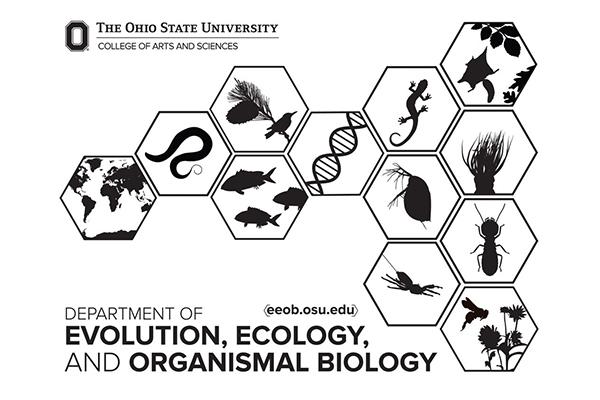EEOB Publications December 1 - December 31

Biogeography of arbuscular mycorrhizal fungal spore traits along an aridity gradient, and responses to experimental rainfall manipulation
Coline Deveautour, Jeff Chieppa, Uffe N. Nielsen, Matthias M. Boer, Christopher Mitchell, Sebastian Horn, Sally A. Power, Alberto Guillen, Alison E. Bennett, Jeff R. Powell. 2019. Fungal Ecology. DOI: 10.1016/j.funeco.2019.100899
Abstract
Spore size, colour and melanin content are hypothesised to be functional in relation to environmental stress. Here, we studied AM fungal spores in arid environments of Australia and in an experimental platform simulating altered rainfall. We used microscopy and image analysis to measure spore colour and size, and a quantitative colorimetric assay to estimate melanin content in spores. In arid sites, melanin content tended to increase with increasing aridity. We observed a large range of spore colours at all sites but found a higher proportion of both dark and light spores, and fewer intermediate colours, in drier sites. Spore abundance and size varied among sites, but neither were related to aridity. In the experimental platform established in a grassland, we found no evidence that altered rainfall influenced spore traits. This study identifies traits associated with environmental stress to inform future work into AM fungal life history and assembly processes.
Lipid class composition of annually bleached Caribbean corals
Sarah L. Solomon, Andréa G. Grottoli, Mark E. Warner, Stephen Levas, Verena Schoepf & Agustí Muñoz-Garcia. 2019. Marine Biology. 167,7. DOI: 10.1007/s00227-019-3616-z
Abstract
Corals with high levels of total lipids are known to have increased resilience potential to bleaching, and lipid class management may shed further light on why some species are more resilient to, or are able to acclimatize to, annual bleaching stress. Here, we measured the lipid class composition of three species of Caribbean corals (Porites astreoides, Porites divaricata, and Orbicella faveolata) collected in July 2009 near Puerto Morelos, Mexico (20° 50′ N, 86° 52′ W) that were experimentally bleached 2 years in a row. Our results show that single bleaching can significantly alter lipid class composition in all species, while repeated bleaching can result in stable (i.e., acclimatized) or even more altered (i.e., not acclimatized) lipid class composition depending on the species. Specifically, P. divaricata and O. faveolata both had altered lipid class composition with losses in storage lipids following single bleaching, but maintained lipid class composition following repeated bleaching stress. However, both single and repeated bleaching altered the lipid class composition in P. astreoides, with changes persisting for the 6 weeks after repeated bleaching stress. This study provides evidence that lipid class management is part of the suite of variables associated with coral resilience, that P. divaricata and O. faveolata acclimatize their lipid class management in response to repeated bleaching stress, but that P. astreoides does not. Corals like P. divaricata and O. faveolata may, therefore, be more suitable for coral restoration efforts since they are more likely to persist under chronic repeat bleaching scenarios predicted for later this century.
Thermal niche diversity and trophic redundancy drive neutral effects of warming on energy flux through a stream food web
Daniel Nelson, Jonathan P. Benstead, Alexander D. Huryn, Wyatt F. Cross, James M. Hood, Philip W. Johnson, James R. Junker, Gísli M. Gíslason, Jón S. Ólafsson. 2019. DOI: 10.1002/ecy.2952
Abstract
Climate warming is predicted to alter routing and flows of energy through food webs due to the critical and varied effects of temperature on physiological rates, community structure, and trophic dynamics. Few studies, however, have experimentally assessed the net effect of warming on energy flux and food web dynamics in natural intact communities. Here, we test how warming affects energy flux and the trophic basis of production in a natural invertebrate food web by experimentally heating a stream reach in southwest Iceland by ~4°C for two years and comparing its response to an unheated reference stream. Previous results from this experiment showed that warming led to shifts in the structure of the invertebrate assemblage, with estimated increases in total metabolic demand but no change in annual secondary production. We hypothesized that elevated metabolic demand and invariant secondary production would combine to increase total consumption of organic matter in the food web, if diet composition did not change appreciably with warming. Dietary composition of primary consumers indeed varied little between streams and among years, with gut contents primarily consisting of diatoms (72.9%) and amorphous detritus (19.5%). Diatoms dominated the trophic basis of production of primary consumers in both study streams, contributing 79 – 86% to secondary production. Although warming increased the flux of filamentous algae within the food web, total resource consumption did not increase as predicted. The neutral net effect of warming on total energy flow through the food web was a result of taxon‐level variation in responses to warming, a neutral effect on total invertebrate production, and strong trophic redundancy within the invertebrate assemblage. Thus, food webs characterized by a high degree of trophic redundancy may be more resistant to the effects of climate warming than those with more diverse and specialized consumers.
